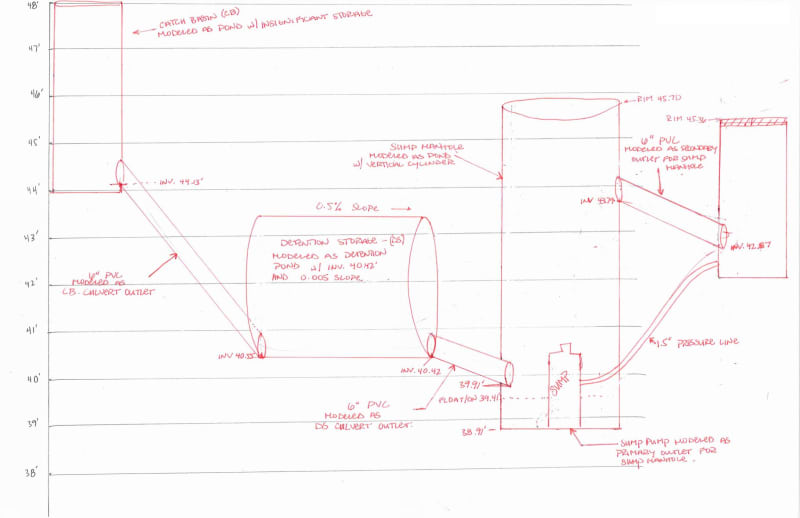Hi again,
I believe I'm modeling my design properly, but I'm having trouble interpreting one of the results. I've attached the file for reference.
Essentially I have a simple system with a Catchment area feeding into a Catch Basin which flows into a detention pond (36" pipe 25 ft. long). This storage pipe has an invert of 40.55, and the top of the pipe is at approximately 43.50'.
The storage pipe outlets via a 6" culvert, and flows into a sump. The pump overflow is at 43'.
Now for the results. The report shows that the pump's overflow (el. 43') is being used during the storm, but the Detention System shows a Peak Elevation of only 40.61'. To the contrary, I get a warning that my detention pond has "Submerged Pond CB1 Primary Device (inv. 44')
If the upstream to downstream flow is Catch Basin > Detention > Sump, how can I simultaneously be A) Triggering my pump overflow downstream at 43' B) Overtopping my catch basin invert at 44' and C) Have max elevation in my detention pipe of 40.61.'
It makes sense that the pump's overflow is being triggered, AND it makes sense that the catch basin has some overtopping at the invert. What doesn't make sense is how my detention pond, which SHOULD be almost completely full, has a peak elevation of 40.61'.
Please see attached hydroCAD file.
Thanks for any help in advance,
I believe I'm modeling my design properly, but I'm having trouble interpreting one of the results. I've attached the file for reference.
Essentially I have a simple system with a Catchment area feeding into a Catch Basin which flows into a detention pond (36" pipe 25 ft. long). This storage pipe has an invert of 40.55, and the top of the pipe is at approximately 43.50'.
The storage pipe outlets via a 6" culvert, and flows into a sump. The pump overflow is at 43'.
Now for the results. The report shows that the pump's overflow (el. 43') is being used during the storm, but the Detention System shows a Peak Elevation of only 40.61'. To the contrary, I get a warning that my detention pond has "Submerged Pond CB1 Primary Device (inv. 44')
If the upstream to downstream flow is Catch Basin > Detention > Sump, how can I simultaneously be A) Triggering my pump overflow downstream at 43' B) Overtopping my catch basin invert at 44' and C) Have max elevation in my detention pipe of 40.61.'
It makes sense that the pump's overflow is being triggered, AND it makes sense that the catch basin has some overtopping at the invert. What doesn't make sense is how my detention pond, which SHOULD be almost completely full, has a peak elevation of 40.61'.
Please see attached hydroCAD file.
Thanks for any help in advance,

